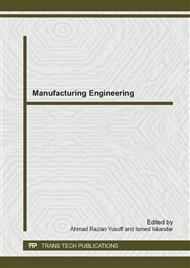[1]
J.C. Spender and Grant, Making Knowledge the Basis of A Dynamic Theory of the Firm, Strategic Management Journal, Vol. 17, (1996) 45-62.
DOI: 10.1002/smj.4250171106
Google Scholar
[2]
J. Hofer-Alfeis, Effective Integration of Knowledge Management into the Business Starts with a Top-down Knowledge Strategy. Journal of Universal Computer Science, Vol. 9, No. 7, (2003) 719-728.
Google Scholar
[3]
T.A. Stewart, Intellectual Capital: The New Wealth of Organizations, Doubleday, New York(1997).
Google Scholar
[4]
R.O., Barclay, Leading the Knowledge Enterprise CIOs, CLOs and Beyond, Corporate Education. Biz, LCC, NY, (2000).
Google Scholar
[5]
I. Nonaka., and T. Nishiguchi., Knowledge Emergence: Social, Technical, and Evolutionary Dimensions of Knowledge Creation, Oxford University Press, New York(2000).
Google Scholar
[6]
R.R. Nels., P.A. Todd and B.H. Wixom., 'Antecedents of information and system quality: an empirical examination within the context of data warehousing', Journal of Management Information Systems, Vol. 21 No. 4, (2005) 199-235.
DOI: 10.1080/07421222.2005.11045823
Google Scholar
[7]
S. Yu, Y. Kim, andM. Kim., 'Do we know what really drives KM performance?', Journal of Knowledge Management, Vol. 11 No. 6, (2007), 39-53.
DOI: 10.1108/13673270710832154
Google Scholar
[8]
B.C. O'Connor., Explorations in indexing and abstracting: Pointing, virtue, and power. Library and Information Science Text Series. Englewood, CO: Libraries Unlimited(1996).
Google Scholar
[9]
H.F. Lin, and G.G. Lee., Perceptions of senior managers toward knowledge-sharing behaviour, Management Decision, Vol. 42 No. 1, (2004)108-25.
DOI: 10.1108/00251740410510181
Google Scholar
[10]
I. Nonaka, and D.J. Teece, Managing Industrial Knowledge: Creating, Transfer, and Utilization, Sage, London, (2001).
Google Scholar
[11]
D.K. Yoo, M.A. Vonderembse, and T.S. Ragu-Nathan, Knowledge quality: antecedents and consequence in project teams, Journal of Knowledge Management, vol. 15 No. 2, (2010) 329-343.
DOI: 10.1108/13673271111119727
Google Scholar
[12]
J. Chen, Z. Zhaohui, and H.Y. Xie, Measuring intellectual capital, Journal of IntellectualCapital, Vol. 5 No. 1, pp.195-212, (2004).
Google Scholar
[13]
S. Herkema, A complex adaptive perspective on learning within innovation projects, The Learning Organization, Vol. 10 No. 6, pp.340-6(2003).
DOI: 10.1108/09696470310497177
Google Scholar
[14]
X. Martin, and R. Salomon, Knowledge transfer capacity and its implications for the theory of the multinational corporation, Journal of International Business Studies, Vol. 34 No. 4, p.356–373, (2003).
DOI: 10.1057/palgrave.jibs.8400037
Google Scholar
[15]
D.C. Blair, D. C., Knowledge management: Hype, hope, or help?, Journal of the American Society for Information Science and Technology, Vol. 53No. 12, pp.1019-1028, (2002).
DOI: 10.1002/asi.10113
Google Scholar
[16]
J.A.B. Vasconcelos, C. Kimble, F. Ribeiro Gouveia, D. Kudenko, Reasoning in corporate memory systems: a case study of group competency, in: S. Tsuchiya, J. -P. Barthès (Eds. ), Proceedings of the 8th International Symposium on the Management of Industrial and Corporate Knowledge (ISMICK01), BUTC, Compiègne, France, p.243–253, (2001).
Google Scholar
[17]
Wang, R.Y., Lee, Y.W., Pipino, L.L. and Strong, D.M., Manage your information as a product, Sloan Management Review, Vol. 39 No. 4, pp.95-105, (1998).
Google Scholar


